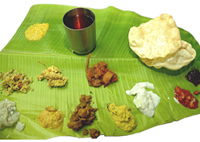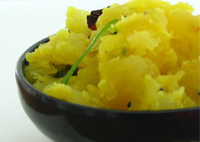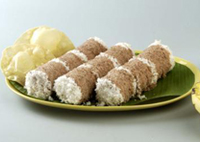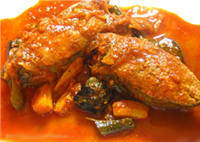Sea Foods & Cuisine
 Cuisine of Kerala
Cuisine of Kerala
The unusual cuisine of Thrikkunnapuzha brings to the fore the culinary expertise of the people of Kerala. Producing some of the tastiest foods on earth, the people of Kerala are gourmets with a difference. The cuisine is very hot and spicy and offers several gastronomic opportunities. The food is generally fresh, aromatic and flavoured. Keralites are mostly fish-and-rice eating people.The land and the food are rich with coconut, though one can’t imagine Kerala food without chilies, curry leaf, mustard seed, tamarind and as afoetida. Just a pinchful of tamarind can substitute tomatoes, but there is no real substitute for curry leaf. Since time immemorial, coconut has been an integral part of the cuisine of Kerala. These people put to good use whatever the land offers and the result is a marvellous cuisine that is simple yet palate tickling. They relish equally a dish as simple as ‘kanji’ (rice gruel) or as extravagant as the ‘sadya’ (feast)
Specialties in Kerala Cuisine
Kerala is known for its delectable vegetarian and seafood cuisine. Meals in Kerala are traditionally eaten using the fingers, from a plate that consists of a fresh banana leaf. With coconut and coconut milk liberally used to thicken curries and the legendary spices of Kerala adding a dash of flavor to various dishes, the cuisine of Kerala is sure to leave you licking your fingers and asking for more. These people put to good use whatever the land offers and the result is a marvelous cuisine that is simple yet palate tickling.
Coconuts in Kerala Cuisine:From time immemorial, the coconut tree has been an integral part of life for the people of Kerala and nowhere is this more visible than in their food. Coconuts in Kerala are used extensively in the delicious cuisine of this state. The juice of the tender coconut is drunk fresh, the soft flesh of the tender coconut is eaten raw, and the mature flesh is grated and added to curries or added as garnishing in either fresh or fried form. Coconut oil is extracted from the dry flesh of the coconut and is used for cooking as its distinctive taste adds a special touch to the cuisine of Kerala. The dried and desiccated flesh of the coconut, called copra, is stored for use in cookery and as offerings in temples. A favorite drink made in Kerala is toddy or fermented palm wine, which is extracted from the coconut palm. Coconuts in Kerala are essential for the preparation of favorite dishes such as coconut chutney, avial (mixed vegetable curry) and fish moilee. A true Malayalee cannot imagine what life would be like without coconuts in Kerala.
Kerala is noted for its variety of pancakes and steamed rice cakes made from pounded rice. Though the same ingredients are used all over the state, each of the communities has its own specialties
For the Muslims, the lightly flavored biryani-made of mutton, chicken, egg or fish-takes pride of place. In seafood, mussels are a favorite. A concoction of mussel and rice flour, cooked in the shell is called arikadaka. The Arab influence on the local cuisine is very visible in the rich meat curries and desserts. A community of Muslims who live in an area called Kuttichara, have a special dish-a whole roasted goat stuffed with chickens inside which are eggs.
For the Christians, who can be seen in large concentration in areas like Kottayam and Pala, ishtew (a derivation of the European stew), with appam is a must for every marriage reception. There would also be beef cutlets with sallas (a salad made of finely cut onions, green chilies and vinegar), chicken roast, olathan erachi (fried mutton, beef or pork), meen moilee (a yellow fish curry), meen mulligattathu (a fiery red fish curry), and peera pattichathu (a dry fish dish of grated coconut). Another interesting feature is the abundant use of coconut oil, mustard seeds, curry leaves, and coconut milk.
Kerala also has it’s own fermented beverages -the famous kallu or (toddy) and patta charayam (arrack). Arrack is extremely intoxicating and is usually consumed with spicy pickles and boiled eggs (patta and mutta).
Appam Appam is the soft pancake made from toddy fermented rice batter, with a soft spongy middle, which is laced with crispy edges. It is generally consumed with either vegetable or chicken or mutton stew, thoroughly mellowed with thick coconut milk and garnished with curry leaves.
Puttu A type of steam cake, ‘Puttu’ is made from rice flour and steamed in long hollow bamboo or metal cylinders. Depending on the taste preference, Puttu can be had with steamed bananas and sugar or with a spicy curry made from gram or chickpeas.
Tapioca And Fish CurryA sumptuous, mouthwatering delicacy, it’s a not- to- be-missed combination of ‘Kappa’ and ‘Meen curry’. With natural flavours erupting out of it liberally, the fish curry is made with garlic paste, onions and red chillies and seasoned with mustard seeds and curry leaves.
Pulaos, pilaffs and biriyanis are meats spices and onions slowly steam cooked in boiled rice. Malabar biriyani was brought across the Indian Ocean by Arab Seafarers. It should be eaten hot with crispy, crunchy pappads.
Iddlis or fluffy white steamed cakes and dosas which
are thin golden pancakes are popular in Kerala. They are made up of
yeasty rice and lentil batter. They are not strictly Malayali Cuisine.
They came across from the vegetarian kitchens next door in the State of
Tamil Nadu.
Kerala does have its own well developed vegetarian cuisine. If you visit
the State during post harvest Onam season lunch with thoran or kaalan
or pachadi or olen.Thorans are gravy-less dishes of
finely chopped boiled vegetables and possibly meet and sea food. The
mustard seed used in thorans gives them a pleasantly assertive flavour,
while the lightly fried grated coconut adds the church.
Avialon the other hand, is mixed vegetable gravy dish
thickened with coconut and yoghurt. Drumsticks, jack fruit seeds and
slices of mango are foten used.
Olen is also a very gravy dish made of ash gourd and drum beans where
the predominant flavour is that of coconut milk. It is a fairly thick
liquid squeezed out from the white flesh of a fresh coconut.
Bananas are very popular in Kerala Cuisine. Sliced
finely and deep fried as chips, they are chewy snacks. Cut into bits,
fried and dipped in jaggerey or sugar syrup, they are sweets. Cooked in
thick yoghurt and seasoned with chilly, turmeric cumin seed and curry
leaves, they become Kaalan accompainment to the main meal.
Malayalee Pachadi is a fairly thick sauce made of
sugar, yoghurt, grated coconut, mustard seed and a wide spectrum range
of spices including green and red chillies.
Sambar is a cross between a sauce and a broth. It
contains smashed lentils, cooked vegetables and spices including the
exotic and edible resin asafoetida. For desert, there is the Pradhman or
Payasam, porridge like sweets with a vermicelli of rice base, cooked in
milk and sugar or jaggery


